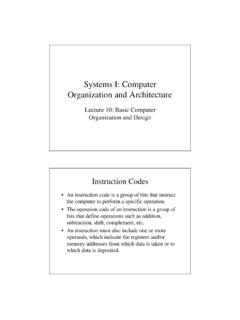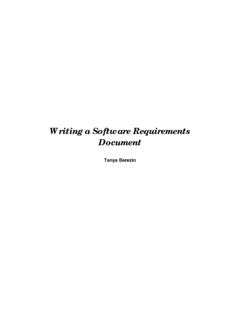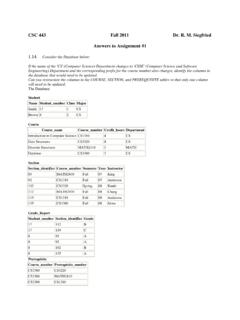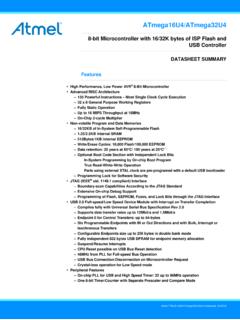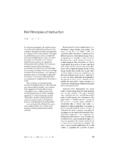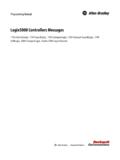Transcription of Systems I: Computer Organization and Architecture
1 Systems I: Computer Organization and ArchitectureLecture 9 - Register Transfer and MicrooperationsMicrooperations Digital Systems are modular in nature, with modules containing registers, decoders, arithmetic elements, control logic, etc. These digital components are defined by the registers that they contain and the operations performed on their data. These operations are called microoperations. Microoperations are elementary operations performed on the information stored in one or more Organization The hardware Organization of a digital Computer is best defined by specifying: The set of register that it contains and their function. The sequence of microoperations performed on the binary information stored in the registers.
2 The control signals that initiates the sequence of Transfer Language A register transfer language is a notation used to describe the microperation transfers between registers. It is a system for expressing in symbolic form the microoperation sequences among register that are used to implement machine-language and Register Transfer Registers are denoted by capital letters and are sometimes followed by numerals, , MAR Memory Address Register (holds addresses for the memory unit) PC Program Counter (holds the next instruction s address) IR Instruction Register (holds the instruction being executed) R1 Register 1 (a CPU register) We can indicate individual bits by placing them in parentheses, , PC(8-15), R2(5), Diagrams of RegistersR1 Register RShowing Individual Bits7 6 5 4 3 2 1 0R1 Numbering of Bits150 Divided Into Two Parts15PC(L)
3 PC(H)708 Register Transfer Language Instructions Register TransferR2 R1 Simultaneous TransferR2 R1, R1 R2 Conditional Transfer (Control Function)P: R2 R1 orIf (P = 1) Then R2 R1 Conditional, Simultaneous TransferT: R2 R1, R1 R2 Basic Symbols For Register TransferR2 R1, R1 R1 Separates 2 microoperationsComma ,R2 R1 Denotes Transfer of informationArrow R2(0-7), R2(L)Denotes a part of a registerParentheses ( )MAR, R2 Denotes a registerLetters (and numerals)ExamplesDescriptionSymbolRegist er Transfer and Hardware Every statement in Register Transfer Language implies the existence of hardware that implements the microoperation. The statement P: R2 R1 implies the existence of the necessary circuitry to implement the transfer as well as the mechanism to set and clear the control variable from R1 to R2 when P = 1 ClockControlcircuitR2R1nLoadThe Bus A bus is a set of common wires that carries data between registers.
4 There is a separate wire for every bit in the registers. There are also a set of control signals which determines which register is selected by the bus at a particular time. A bus can be constructed using multiplexer which enable a sets of registers to share a common bus for data Transfer Using the Bus The select lines S1and S0indicate which of four register will have its contents transferred to the bus. In general, a bus system will multiplex kregisters of nbit each to produce a n line common bus. It will require nk x 1 multiplexers. The bus is connected to the inputs of all destination registers. and will activate the load control of the selected register when it is ready to transfer data. This can be written as: R2 BUS, BUS R1orR2 R1 Function Table for the BusD11C01B10A00 Register SelectedS0S1 Bus System For 4 Registers4 x 1 MUX 33 2 1 04 x 1 MUX 23 2 1 04 x 1 MUX 13 2 1 04 x 1 MUX 03 2 1 0S0S14 Common-BusLine3 2 1 0 Register D3 2 1 0 Register C3 2 1 0 Register B3 2 1 0 Register AB2B1B0C1C2C0D1D2D0B1C1D1B0C0D0B2C2D2 Three State-Bus Buffers A bus can be built using three-state buffers instead of multiplexers.
5 A three-state gate has three states: 1, 0 and a high-impedance state, which behaves like an open circuit. It is possible to connect a large number of three-state gates in a common bus line without overloading Symbols For Three State-BufferNormal input AControl input COutput Y = A if C = 1 High-impedanceif C=0 Bus Line With Three-State Buffers2 x 4decoderS1S0E1230B0C0D0A0 Bus line for bit 0 SelectsEnableMemory Transfer There are two primary operations involving memory: Read transferring data frommemory Write transferring data intomemory To indicate in Register Transfer Language that we are moving data from a memory address to the data register, we write:Read: DR M[AR] To indicate in RTL that we are moving data from Register 1 to a memory location, we write:Write.
6 M[AR] R1 Microoperations Microoperations are classified into four categories: Register transfer microoperations (data moves from register to register) Arithmetic microoperations (perform arithmetic on data in registers) Logic microoperations (perform bit manipulation on data in registers) Shift microoperations (perform shift on data in registers)Arithmetic Microoperations Unlike register transfer microoperations, arithmetic microoperations change the information content. The basic arithmetic microoperations are: addition subtraction increment decrement shiftArithmetic Microoperations (continued) The RTL statement:R3 R1 + R2indicates an add microoperation. We can similarly specify the other arithmetic microoperations.
7 Multiplication and division are not considered microoperations. Multiplication is implemented by a sequence of adds and shifts. Division is implemented by a sequence of substracts and MicrooperationsDecrement content of R1 by 1R1 R1 - 1 Increment content of R1 by 1R1 R1 + 1R1 plus 2 s comp. of R2R3 R1+R2 + 12 s complment contens of R2 (negate)R2 R2 + 1 Complement contents of R2 (1 s comp.)R2 R2 Contents of R1 minus R2 transferred to R3R3 R1 R2 Contents of R1 plus R2 transferred to R3R3 R1 + R2 DescriptionSymbolic DesignationBinary Adder We implement a binary adder with registers to hold the data and a digital circuit to perform the addition (called a binary adder). The binary adders is constructed using full adders connected in cascade so that the carry produced by one full adder becomes an input for the next.
8 Adding two n-bit numbers requires nfull adders. The ndata bits for Aand Bmight come from R1and R2respectively4-Bit Binary AdderFAFAFAFAC0C1C2C3C4S0S1S2S3B0A0B1A1B 2A2B3A3 Adder-Subtracter Subtracting A B is most easily done by adding B toAand then adding 1. This makes it convenient to combine both addition and subtraction into one circuit, called an adder-subtracter. M is the mode indicator M = 0 indicates addition (B is left alone and C0is 0) M = 1 indicates subtraction (B is complement and C0is 1).4-Bit Adder-SubtractorFAFAFAFAC0C1C2C3C4S0S1S2 S3B0A0B1A1B2A2B3A3 MBinary Incrementer The binary incrementer adds 1 to the contents of a register, , a register storing 0101 would have 0110 in it after being incremented.
9 There are times when we want incrementing done independent of a register. We can accomplish this with a series of cascading Binary IncrementerHAxySCS3C4A3 HAxySCS2A2 HAxySCS1A1 HAxySCS0A01 Arithmetic Circuit We can implement 7 arithmetic micro-operations (add, add with carry, subtract, subtract with borrow, increment, decrement and transfer) with one circuit. We provide a series of cascading full adders with Aiand the output of a 4x1 multiplexer. The multiplexers inputs are two selects, Bi, Bi , logical 0 and logical 1. Which of these four values we provide (together with the carry) determines which microoperation is Circuit Function TableTransfer AD = A1111 Decrement AD = A 11011 Increment AD = A + 10101 Transfer AD = A0001subtractD = A + B + 1B110 Subtract with BorrowD = A + BB010 Add with CarryD = A + B + 1B100 AddD = A + BB000 MicrooperationD = A + Y + CinYCinS0S1 SelectInputOutput4-Bit Arithmetic CircuitX0Y0C0C1 FAD0X1Y1C1C2 FAD1X2Y2C2C3 FAD2X3Y3C3C4 FAD3cout4 x 1 MUXS1S001234 x 1 MUXS1S001234 x 1 MUXS1S001234 x 1 MUXS1S00123cinS1S0A1A2A3A0B0B1B2B30 The Microoperations of the Arithmetic Circuit When S1S0= 00, the MUX provides B.
10 The result is Add (for Cin= 0) or Add With Carry (for Cin= 1). When S1S0= 01, the MUX provides B . The result is Subtract with Borrow (for Cin= 0) or Subtract (for Cin= 1). When S1S0= 10, the MUX provides 0. The result is Transfer (for Cin= 0) or Increment (for Cin= 1). When S1S0= 11, the MUX provides 1. The result is Decrement (for Cin= 0) or Transfer (for Cin= 1).Logic Microoperations Logic microoperations are binary operations performed on corresponding bits of two bit strings. Example: P: R1 R1 R21010 Content of R11100 Content of R20110 Content of R1 after P = 1 Special Symbols used for logic operations: - AND - OR - XORThis avoids confusing AND with multiplication, OR with addition, Tables for 16 2-Variable Function10101010111100110001111100001000 00000000F7F6F5F4F3F2F1F0yxTruth Tables for 16 2-Variable Function (continued)10101010111100110001111100001 01111111100F15F14F13F12F11F10F9F8yxSixte en Logic MicrooperationsORF A BF7= x + yExclusive-ORF A BF6= x yTransfer BF BF5= yF A BF4= x yTransfer AF AF3= xF A BF2= xy ANDF A BF1= xyClearF 0F0= 0 NameMicrooperation Boolean FunctionSixteen Logic Microoperations (continued)NameMicrooperation Boolean FunctionSet to all 1 sF all 1 sF15= 1 NANDF A BF14= (xy)
